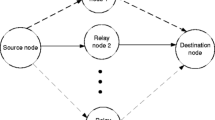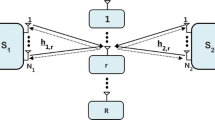Abstract
In this work, we study the \(N\)th best relay selection schemes with the consideration that in some case the best relay is unavailable due to the restriction of practical implementation. With amplify-and-forward relaying protocols, the interested \(N\)th best relay schemes are investigated over independent and non-identically distributed (i.ni.d) Nakagami-\(m\) fading channels. For such opportunistic relaying schemes, we first obtain the closed-form expressions to the probability density function (PDF) and cumulative distribution function (CDF) of the instantaneous end-to-end signal-to-noise ratio with appropriate mathematical proof. Then, with the obtained CDF and PDF, three main measurements are investigated as well as the corresponding explicit solutions, \(i.e.\), outage probability, average symbol error ratio (SER), and ergodic capacity. At the same time, as a byproduct, the corresponding performance metrics over Rayleigh fading are also derived. Finally, the detailed performance comparison analyses are presented under different values of \(N\) and different Nakagami-\(m\) channel fading severity parameters. The numerical results show that the increase of \(N\) incurs the very severe loss in performance such outage probability, SER, and ergodic capacity. However, the loss in performance can be decreased greatly when the \(N\)th systems have bigger fading severity factors. The derivations are of significance because the Nakagami-\(m\) fading spans via the fading severity parameters a wide range of fading scenarios that are typical in realistic wireless relay networks.





Similar content being viewed by others
References
Jia, X., & Yang, L. (2011). Interaction of multiplexing gains and power exponents allocation of two-level superposition coding relaying. European Transactions on Telecommunications, 22(7), 352–366.
Haiyang, D., Jianhua, G., Benevides, D., & Zhuoqin, J. (2012). Two birds with one stone: Exploiting direct links for multiuser two-way relaying systems. IEEE Transactions on Wireless Communications, 11(1), 54–59.
Jia, X., Yang, L., & Fu, H. (2011). Tight performance bounds for two-way opportunistic amplify-and-forward wireless relaying networks with TDBC protocols. Eurasip Journal on Wireless Communications and Networking, 2011(1), 1–8.
Jia, X., Fu, H., Yang, L., & Zhao, L. (2011). Superposition coding cooperative relaying communications: Outage performance analysis. International Journal of Communication Systems, 24(3), 384–397.
Sendonaris, A., Erkip, E., Aazhang, B., & Sendonaris, A. (2003). User cooperation diversity. Part I. System description. IEEE Transactions on Communications, 51(11), 1927–1938.
Laneman, N., Tse, C., & Wornell, G. (2004). Cooperative diversity in wireless networks: Efficient protocols and outage behavior. IEEE Transactions on Information Theory, 50(12), 3062–3080.
Bletsas, A., Khisti, A., Reed, D., & Lippman, A. (2006). A simple cooperative diversity method based on network path selection. IEEE Journal on Selected Areas in Communications, 24(3), 72–659.
Laneman, J., & Wornell, G. (2003). Distributed space-time-coded protocols for exploiting cooperative diversity in wireless networks. IEEE Transactions on Information Theory, 49(10), 2415–2425.
Haifang, J., Sihai, Z., & Wuyang, Z. (2011). Outage analysis of distributed scheme on opportunistic relaying with limited CSI. IEEE Communications Letters, 15(9), 935–937.
In-Ho, L., & Dongwoo, K. (2012). Outage performance of opportunistic cooperation in amplify-and-forward relaying systems with relay selection. IEEE Communications Letters, 16(2), 224–227.
Xiaowen, G., Chandrashekhar, T., Junshan, Z., & Poor, H. (2012). Opportunistic cooperative networking: To relay or not to relay? IEEE Journal on Selected Areas in Communications, 30(2), 307–314.
MinChul, J., Il-Min, K., & Dong, K. (2012). Joint relay selection and relay ordering for DF-based cooperative relay networks. IEEE Transactions on Communications, 60(4), 908–915.
Min, Z., Qimei, C., Jantti, R., & Tao, X. (2012). Energy-efficient relay selection and power allocation for two-way relay channel with analog network coding. IEEE Communications Letters, 16(6), 1–4.
Ubaidulla, P., & Aissa, S. (2012). Optimal relay selection and power allocation for cognitive two-way relaying networks. IEEE Wireless Communications Letters, 1(3), 225–228.
Jia, X., Yang, L., Fu, H., Feng, B., & Qi, Y. (2012). Two-way denoise-and-forward network coding opportunistic relaying with jointing adaptive modulation relay selection criterions. IET Communications, 6(2), 194–202.
Xu, C., Ting-wai, S., Zhou, Q., & Lau, F. (2010). High-SNR analysis of opportunistic relaying based on the maximum harmonic mean selection criterion. IEEE Signal Processing Letters, 17(8), 719–722.
Krikidis, I., Thompson, J., McLaughlin, S., & Goertz, N. (2009). Max-min relay selection for legacy amplify-and-forward systems with interference. IEEE Transactions on Wireless Communications, 8(6), 3016–3027.
Ikki, S., & Ahmed, M. (2010). On the performance of cooperative-diversity networks with the \(N\)th best-relay selection scheme. IEEE Transactions on Communications, 58(11), 3062–3069.
Ikki, S., & Ahmed, M. (2009). On the performance of amplify-and-forward cooperative diversity with the \(N\)th best-relay selection scheme. In Proceeding of ICC ’09, Dresden, June 2009 (pp. 1–6, 14–18).
Ikki, S., & Ahmed, M. (2009). On the performance of adaptive decode-and-forward cooperative diversity with the Nth best-relay selection scheme. In Proceeding of IEEE GLOBECOM 2009, Honolulu, HI, November 30–December 4 2009 (pp. 1–6).
Kyunbyoung, K., Jeongtae, S., & Choongchae, W. (2011). Another closed-form expression of average error rate for the \(N\)th best relay selection AF relaying over Rayleigh fading channels. In Proceeding of 2011 international conference on ICT, 2011 (pp. 106–109).
Shao, I. (2011). Performance of amplify-and-forward cooperative communications with the \(N\)th best-relay selection scheme over Nakagami-\(m\) fading channels. IEEE Communications Letters, 15(2), 172–174.
Jing, Y., Pingzhi, F., Duong, T., & Xianfu, L. (2011). Exact performance of two-way AF relaying in Nakagami-\(m\) fading environment. IEEE Transactions on Wireless Communications, 10(3), 980–987.
Upadhyay, P., & Prakriya, S. (2011). Performance of two-way opportunistic relaying with analog network coding over Nakagami-\(m\) fading. IEEE Transactions on Vehicular Technology, 60(4), 1965–1971.
Guo, H., & Ge, J. (2011). Performance analysis of two-way opportunistic relaying over Nakagami-\(m\) fading channels. Electronics Letters, 47(2), 150–152.
Minghua, X., Chengwen, X., Yik-Chung, W., & Aissa, S. (2011). Exact performance analysis of dual-hop semi-blind AF relaying over arbitrary Nakagami-\(m\) fading channels. IEEE Transactions on Wireless Communications, 10(10), 3449–3459.
Ferdinand, N., Rajatheva, N., & Latva-aho, M. (2012). Effects of feedback delay in partial relay selection over Nakagami-\(m\) fading channels. IEEE Transactions on Vehicular Technology, 61(4), 1620–1634.
David, H. A., & Nagaraja, H. N. (2003). Order statistics (3rd ed.). New York: Wiley.
Gradshteyn, I. S., & Ryzhik, I. M. (2007). Table of Integrals, series, and products (7th ed.). San Diego, CA: Acdemic.
Acknowledgments
The authors would like to thank the editors and the anonymous reviewers for their constructive comments and suggestions, which helped to improve the quality of this paper. This work was supported by the Natural Science Foundation of China under Grant 61261015, the 973 project 2013CB329104, the Natural Science Foundation of China under Grant 61372124 and 61171093, the key projects 2011ZX03005-004-003 and BK2011027, the China Postdoctoral Science Foundation 2012M521105, Research Fund for the Doctoral Program of Higher Education of China 20113223110001, and by the project 11KJA510001 and PAPD.
Author information
Authors and Affiliations
Corresponding author
Rights and permissions
About this article
Cite this article
Jia, X., Yang, L. & Zhu, H. Performance Comparison Analyses of the \(N\)th Best Relay Selection Schemes Over Independent and Non-identically Distributed Nakagami-\(m\) Fading Channels. Wireless Pers Commun 75, 1355–1372 (2014). https://doi.org/10.1007/s11277-013-1428-x
Published:
Issue Date:
DOI: https://doi.org/10.1007/s11277-013-1428-x




